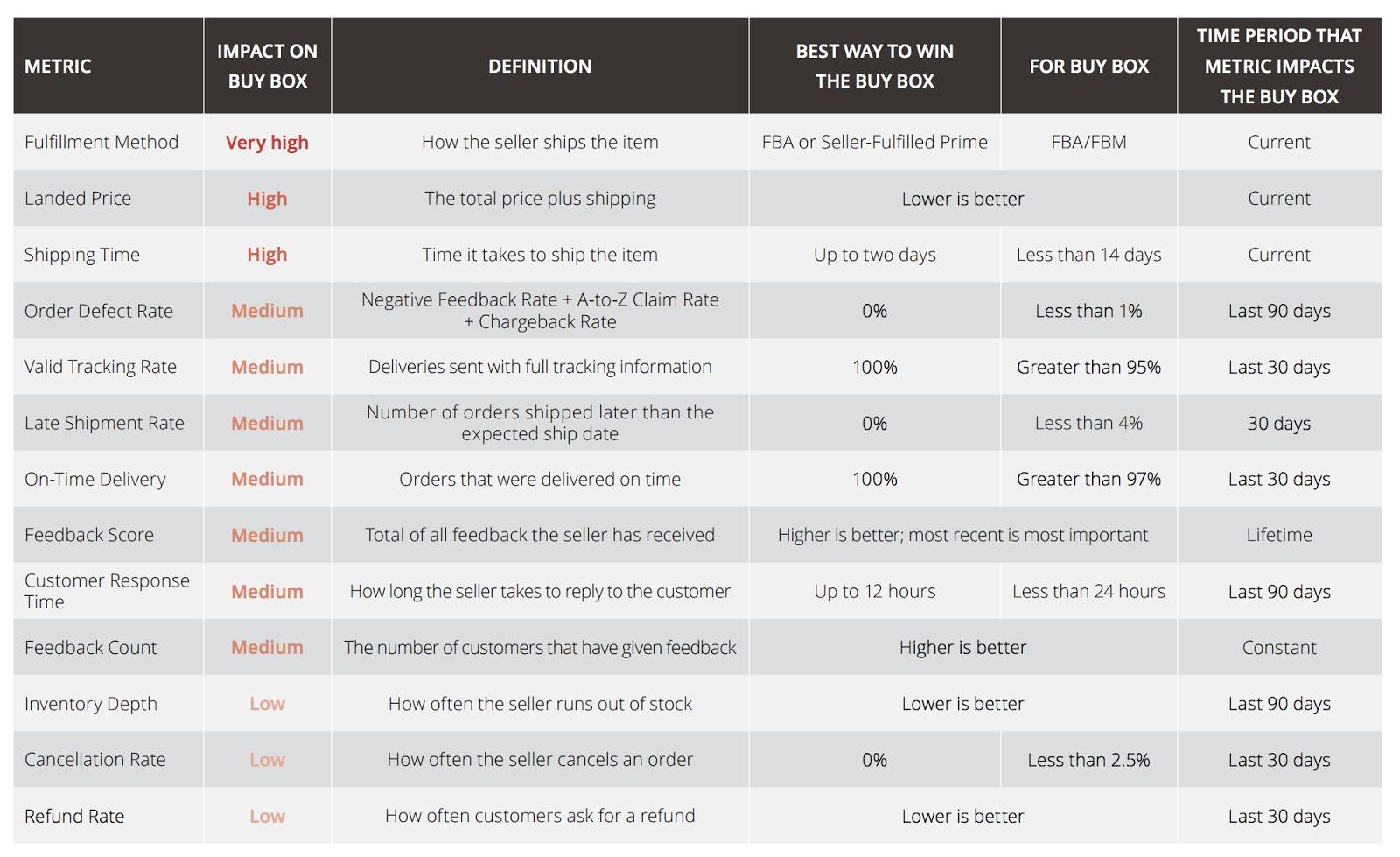Importance of the pricing management in the race for Amazon’s Buy Box
Written by
Editorial TeamPublished on

Price management in shaping the purchase decision
Setting a proper price is essential for achieving exceptional sales results. Surely, it has to be balanced perfectly between cheap, attracting the customers and expensive, providing high margins for the merchant. The research outcome (Akbar & James, 2014); (Mahesh & Nathan, 2015) is unequivocal – a product price has the greatest influence on shaping the customers’ purchase decisions. Therefore, it is crucial to pay great attention to price management.
Additionally, properly set price has a beneficial impact not only on affecting buyers’ mindset, but also on scoring made by marketplaces’ algorithms. For instance, the chances for winning the Amazon’s Buy Box are greatly influenced by offering a low price.
Amazon’s growing value
Amazon sales potential and chances related with actively operating on that platform are obvious. Those, who have any concerns regarding the opportunities that come along selling on Amazon could glimpse at the image below. It pictures recent Amazon’s statistics.

What is Amazon’s Buy Box
Most likely, you’re familiar with the term ‘Buy Box’. The idea behind it is to put a special emphasis on the most favourable offer. What may amaze you is the effectiveness of the solution. It is estimated that over 80% of all sales are completed via Buy Box. Unsurprisingly, the battle for Amazon’s Buy Box is a fierce one.
Winning the Buy Box
As long as it is simple and perfectly clear that being in the Buy Box’s spotlight is crucial for the success, the way of getting there is a bit complicated. Although there are no A to Z tutorials describing rules for the Buy Box race, it is known that keeping some Account Health Metrics at high level is more important than the others. Below you will find the shortlist of most impactful factors regarding your chances of obtaining the Buy Box position. It was published a few years ago and some values have changed since then e.g. cancellation rate on most accounts resets after 7 days, but the most important parts remain unchanged. Bear in mind it’s supposed to be viewed as guidelines only and not the official data from Amazon.

The most common pricing strategies
Undoubtedly, there are plenty of different pricing strategies available to use. So, what are the most commonly used options and what should one bear in mind when considering implementing it? The following is the three most worthy strategies:
- Dynamic pricing
The rationale behind this strategy is to be able to constantly adjust prices in accordance with market situation in order to maximize the profit margin. It requires the merchant to set the lowest and highest acceptable price they could offer and balancing within that range in real-time as a response to the competitors’ actions.
- Competitor-based pricing
This method is based on market behaviour observation and detailed research of the competition. The aim is to find out what price range is offered by the other sellers. After settling the highest, average and the lowest price available, the merchant decides to follow one of three routes:
- setting the price higher than competitors;
- setting the price at the same level as competitors;
- setting the price lower than the competitors.
- Cost-based pricing
In this system offered price is the result of a simple equation. Retailer has to include all the costs of the product from the very beginning of the sales process to the dispatch stage. It consists of, but not limited to, purchase cost, packaging cost, taxes, shipping cost. After that calculation the desired margin is being added. The outcome is the final price for a customer.
Enhanced dynamic pricing as the best strategy
Operating in the FBA model is one of a few most desired factors considered by Amazon when it comes to winning the Buy Box with the total price and shipping time being highly important as well. However, the recipe for successfully combining all of them isn’t as straightforward as it may seem. Besides, the result is not only dependant on your actions. The competition has something to say, too!
Consequently, you need an approach allowing being one step ahead of other merchants. This could be achieved with the dynamic pricing method. Adjusting prices would assure you are maximising your chances of being appreciated by the algorithm regarding the total price of your offer. In order to keep the score high, your prices have to adjust to the slightest response of the market in real-time. Otherwise, even if you had offered the lowest price at first, your competitors could quickly assess and change their prices as well without you even noticing it.
Overall, you also need to introduce certain findings of cost-based pricing. Unless you want to cut your margins to a minimum or even contribute extra resources, you should put a great effort on setting the lowest profitable price you could offer. Doing so, would make you exploit the best aspects of every available strategy.
Retailers’ perspective
First and foremost, using dynamic pricing enables merchants to increase their sales. Depending on current demand, one could raise or lower their price. As consequence the company is either capitalising on demand or getting the product trading again by offering a more compelling price.
As said before, in the Amazon’s reality it is highly important to win the Buy Box. Exploiting the dynamic pricing approach ensures you are in the best possible spot for that. It keeps you competitive. As result you would not scare your customers off with too expensive items nor cause a price war, which undoubtedly is redundant from every merchants’ perspective.
To demonstrate, let’s say the best offer on the market for the new Nike Air Max sneakers is €140. Your lowest profitable price (calculated based on all your expenses) could be €125, but instead of setting the price at such level, the repricing system calculates the variables and chooses €136, which is a little cheaper than the current best offer, granting you bigger than expected margin and still being the market leader pricewise. The customer would probably choose your offer making you earn more on profit margin. How great is that?
Last but not least benefit of exploiting dynamic pricing is the opportunity to learn more about the customers’ purchase behaviors. Adjusting the price in real-time enable you to find out what the demand really is and how much they are willing to pay for a specific product in a certain timespan.
Customers’ perspective
Not only the dynamic pricing benefits the retailers, but also customers. The major aid for the latter is creating a healthy market, which operates in accordance with the best supply and demand practices.
As a result of the Amazon’s policy, sellers are unable to dramatically overprice their products. Such action would cause warnings or even blocking the seller’s account. In general, the dynamic pricing approach, which is the best suit for Amazon sellers, prevents them from either underpricing or overpricing the products. Consequently, the customers can experience the availability of variety of offers from different sellers. Overall, the popularity of dynamic pricing creates the opportunity for customers of shopping on a market free of monopoly or oligopoly.

Dynamic pricing challenges
- Big data management – in case you are an international reseller, you probably offer thousands of products on Amazon. That could be tricky and in such a situation having software that presents data clearly to a user is a must. The success rate could change in minutes. With this in mind, price adjustment should be applied as fast as possible and on all markets. Your profit is at stake. Doing so manually is impossible, but choosing the right software also is not a piece of cake. In addition, there are variety of factors that should be included while calculating the price, i.e. product cost, shipping fees, VAT, etc. Make sure you account for all of them!
- Software malfunction – undoubtedly, using a proper pricing system is an advantage. However, we have to bear in mind that there is always a risk of software malfunction. While accidental change of a price of a single product probably would not cause your company an awful lot of damage, the mishap of batch underpricing will cost you greatly.
- Consumers’ loyalty drops – in spite of all the good the dynamic pricing cause for the customers, it could also backfire, when implemented badly. The potential impact could be even worse, if the bad practices were noticed by the consumer. Despite our best intent, such actions could be perceived as a price discrimination. Subsequently, it is extremely important to bear in mind the specifics of an industry we operate in, as well as the desired customer experience. Some products are prone to be a subject of price changes, but some should remain at fairly constant price level. In order not to insult the customer and lose their interest in our offer, we ought to always consider that.
Summary
As it has already been mentioned, winning the Buy Box is crucial for squeezing Amazon’s sales potential to the last drop. In order to do so, the one should take certain steps including switching to FBA, securing the best shipping deals, but most importantly offering the most competitive total prices.
Without a doubt, there is no single route to achieve that. Different pricing strategies could lead to this goal, but the dynamic pricing seems to be the most suitable and profitable one in terms of influencing the race for Amazon’s Buy Box. While it would not always guarantee the Buy Box, it would ensure your aiming at the customers’ most tempting idea – the lowest possible price.Careful planning of price management and execution with well-developed tools is essential while implementing the dynamic pricing strategy. The process can be fairly complex, but the rewards could outweigh the effort you initially put in.


